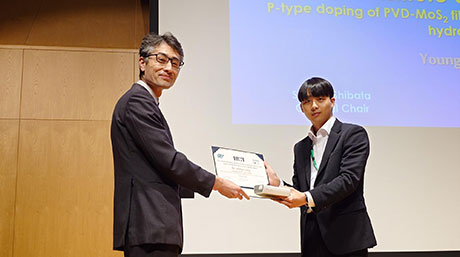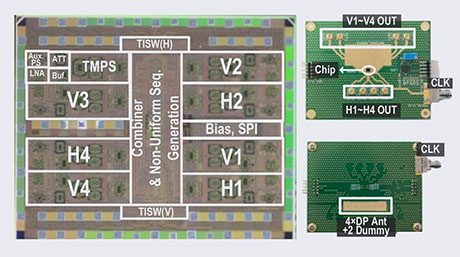Electrical and Electronic Engineering News
Ultra high-speed IC capable of wireless transmission of 100 gigabits per second in a 300 GHz band
Technology expected to pioneer utilization of unexplored terahertz wave frequencies
Nippon Telegraph and Telephone Corporation (NTT; head office: Chiyoda-ku, Tokyo; president & CEO: Hiroo Unoura), and Tokyo Institute of Technology (Tokyo Tech; head office: Meguro-ku, Tokyo; president: Kazuya Masu), have jointly developed an ultra high-speed IC for wireless front-end that operates on a terahertz frequency band, and in the 300 GHz band they have succeeded in developing the world's fastest 100 gigabit per second wireless transmission data rate.
It is expected that unused terahertz waves can be applied to high-speed wireless transmission since a wide frequency band can be secured. In this research, we implemented a mixer circuit that applied a unique proprietary high isolation design technology with an Indium phosphide high electron mobility transistor (InP-HEMT). This enlarged the transmission bandwidth, which is a problem in the conventional 300 GHz band wireless front end. It also improved the signal-to-noise ratio (SNR). In addition, using this we realized a 300 GHz band wireless front-end module, and we achieved wireless transmission of 100 Gbps (gigabits per second).
In this research, we realized 100 Gbps wireless transmission with one wave (one carrier), so in the future, we can extend to multiple carriers by making use of the wide frequency band of 300 GHz band, and use spatial multiplexing technology such as MIMO and OAM. It is expected to be an ultra high-speed IC technology that enables high-capacity wireless transmission of 400 gigabits per second. This is about 400 times the current LTE and Wi-Fi, and 40 times 5G, the next-generation mobile communication technology. It is also expected to be a technology that opens up utilization of the unused terahertz wave frequency band in the communications field and non-communication fields.
The details of this technology will be presented at the 2018 IEEE MTT-S International Microwave Symposium![]() which will be held in Philadelphia in the United States from June 10 to 15.
which will be held in Philadelphia in the United States from June 10 to 15.
Research background
With the spread of broadband networks, high-capacity wireless transmission technology of 100 gigabits per second (Gbps) has attracted worldwide attention (Fig. 1.) There are three ways of further increasing the capacity of wireless transmission— expanding the transmission bandwidth, increasing the modulation multi-level number, and increasing the spatial multiplexing number. To realize future large capacity wireless transmission technology from a level of 400 Gbps to that of one terabit per second (Tbps), it is necessary in one wave (one carrier) to expand both the transmission bandwidth and the modulation multi-level number simultaneously and to increase the number of spatial multiplexing transmissions by superimposing them multiple times.
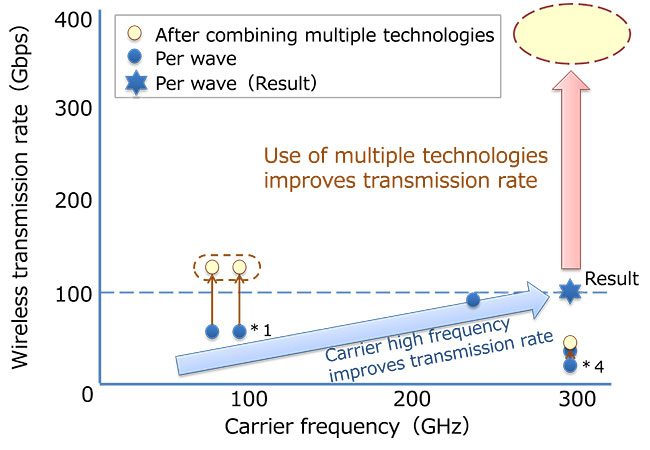
Fig. 1 Development of large capacity wireless transmission technology
In the carrier frequencies from 28 GHz to 110 GHz that are currently being researched and developed, the transmission bandwidth is limited. So, researchers are studying the use of frequencies which make it easier to expand the transmission band area, from the 300 GHz band to the terahertz wave1 frequency band. The 300 GHz band has a frequency that is 10 or more times higher than the 28 GHz band which is being studied for 5G, which will be the next generation mobile communication technology. With the 300 GHz band, it will be easier to secure a wide transmission bandwidth. On the other hand, with a high frequency, leakage of unnecessary signals between the ports inside the IC and mounting tends to occur, and so far, it has been impossible to obtain a sufficiently high signal-to-noise ratio (SNR)2 . For this reason, even if a 300 GHz band is used, it is impossible to obtain both a wide transmission bandwidth and a high modulation multi-level value at the same time, and so wireless transmission up to now has remained at the rate of several-tens Gbps.
Research results
In this research, we devised our own high isolation design technology and applied this technology to a mixer circuit (Fig. 2), which is a key component responsible for frequency conversion in the 300 GHz band wireless front end. We also developed an IC with an indium phosphide high electron mobility transistor (InP-HEMT)3. By applying high isolation design technology, we succeeded in suppressing leakage of unnecessary signals inside each IC and between ports in the IC. We also succeeded in improving signal noise reduction and expanding band width, which had been issues confronting the use of conventional 300 GHz band wireless front end technology up to now. With these technologies, we also realized a 300 GHz band wireless front-end module (Fig. 3), and we confirmed reception of a good 16QAM signal in back-to-back transmission (Fig. 4). In a 300 GHz band, we also confirmed transmission at a speed of 100 Gbps, the first time in the world this speed has been attained (Fig 5).

Fig. 2 Configuration of 300 GHz wireless front end
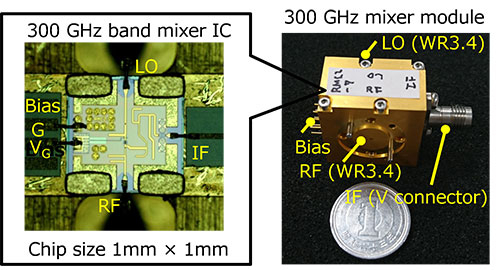
Fig. 3 Mixer IC and module

Fig. 4 Reception constellation by back-to-back transmission
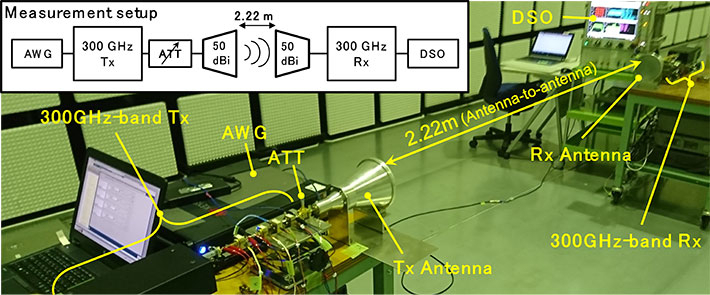
Fig. 5 Transmission experiment
Future developments
In this research, since we realized 100 Gbps transmission with one wave (one carrier), in the future we will expand our research to use multiple carriers or spatial multiplexing technology such as MIMO and OAM together with this results. With this combination, we expect to attain an ultra high-speed IC technology that enables high-capacity wireless transmission of over 400 Gbps. In addition, we expect that our approach can be applied in various fields such as imaging and sensing in which terahertz waves are expected to be used. Through collaboration with partners, NTT aims to create new services and new industries using ultra high-speed ICs, and it aims to further develop ultra high-speed IC technology.
Technical features
We devised a unique high isolation design technology and used this technology to realize a mixer circuit. A mixer circuit has three ports: a Local Oscillation Frequency Port (LO), a Radio Frequency Port (RF), and an Intermediate Frequency Port (IF). When operating with the very high frequency signals of terahertz waves, unnecessary signals leak easily between ports as the result of a small parasitic capacitance on the mixer circuit and external mounting.
By adding a quarter-wave line and series capacitance, we were able to create a unique design that dramatically improved isolation between ports. The high isolation characteristics realized in this way can suppress unnecessary signals, contributing not only to improvement of SNR, but also to prevention of deterioration of frequency characteristics when the mixer IC is mounted on a module. As a result, we achieved both broadband characteristics and high SNR characteristics for a wireless front-end module.
This work was supported in part by the research and development program on multi-tens gigabit wireless communication technology at subterahertz frequencies of Ministry of Internal Affairs and Communications, Japan.
Just as we use the phrase ‘kilo’ to mean 103, so we use the term ‘giga’ to mean 109 and the term ‘tera’ to mean 1012 . "Hertz (Hz)" is a unit of a physical quantity called frequency. It indicates how many times alternating electric signals and electromagnetic waves change polarity (plus and minus) per second. That is, one terahertz (1 THz = 1,000 GHz) is the frequency of the electromagnetic wave changing the polarity by 1 × 1012 times per second. In general, a terahertz wave often indicates an electromagnetic wave of 0.3 THz to 3 THz.
2 Signal-to-noise ratio (SNR) characteristics
Represents the ratio of the power of the signal to the noise.
3 Indium phosphide high electron mobility transistor (InP-HEMT):
High Electron Mobility Transistor (HEMT) using an Indium Phosphide (InP) compound semiconductor.
Reference
| Title of original paper : |
300-GHz, 100-Gb/s InP-HEMT Wireless Transceiver Using a 300-GHz Fundamental Mixer Session Th3F: THz and mm-Wave Sensing and Communication Systems |
|---|
- New 28-GHz transceiver paves the way for future 5G devices | Tokyo Tech News
- Tokyo Tech slashes power consumption in Bluetooth Low-Energy transceiver by more than half | Tokyo Tech News
- Speeding up adoption of 5G! Wireless transmission speeds of 120 Gbps achieved | Tokyo Tech News
- Innovative technology to recover performance of CMOS devices damaged by hot carrier injection | Tokyo Tech News
- Clock generator realized by pure digital circuit | Tokyo Tech News
- 28Gb/s wireless data rate achieved with millimeter-wave transceiver | Tokyo Tech News
- Kenichi Okada - Wiring the world wirelessly | Research Stories | Research
- Okada Lab.
- Researcher Profile | Tokyo Tech STAR Search - Kenichi Okada
- NTT Home Page
- NTT successfully demonstrates 100 Gbps wireless transmission using a new principle (OAM multiplexing) as a world's first | NTT Press Releases
- Opening of Ultra-high-speed IC Technology Using an Advanced Compound Semiconductor Process | NTT Press Releases
- The world's-first compact transceiver for terahertz wireless communication using the 300-GHz band—with transmission rate of several-dozen gigabits per second—was developed and experimentally demonstrated high-speed data transmission. | NTT Press Releases
- Latest Research News
School of Engineering
—Creating New Industries and Advancing Civilization—
Information on School of Engineering inaugurated in April 2016
Further Information
Associate Professor Kenichi Okada
School of Engineering, Tokyo Institute of Technology
Email okada@ee.e.titech.ac.jp
Tel +81-3-5734-2258
Contact
Public Relations Section,
Tokyo Institute of Technology
E-mail media@jim.titech.ac.jp
Tel +81-3-5734-2975



